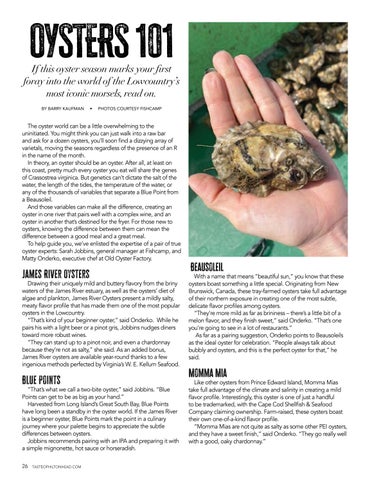OYSTERS 101
If this oyster season marks your first foray into the world of the Lowcountry’s most iconic morsels, read on. BY BARRY KAUFMAN
•
PHOTOS COURTESY FISHCAMP
The oyster world can be a little overwhelming to the uninitiated. You might think you can just walk into a raw bar and ask for a dozen oysters, you’ll soon find a dizzying array of varietals, moving the seasons regardless of the presence of an R in the name of the month. In theory, an oyster should be an oyster. After all, at least on this coast, pretty much every oyster you eat will share the genes of Crassostrea virginica. But genetics can’t dictate the salt of the water, the length of the tides, the temperature of the water, or any of the thousands of variables that separate a Blue Point from a Beausoleil. And those variables can make all the difference, creating an oyster in one river that pairs well with a complex wine, and an oyster in another that’s destined for the fryer. For those new to oysters, knowing the difference between them can mean the difference between a good meal and a great meal. To help guide you, we’ve enlisted the expertise of a pair of true oyster experts: Sarah Jobbins, general manager at Fishcamp, and Matty Onderko, executive chef at Old Oyster Factory.
James River Oysters
Drawing their uniquely mild and buttery flavory from the briny waters of the James River estuary, as well as the oysters’ diet of algae and plankton, James River Oysters present a mildly salty, meaty flavor profile that has made them one of the most popular oysters in the Lowcountry. “That’s kind of your beginner oyster,” said Onderko. While he pairs his with a light beer or a pinot gris, Jobbins nudges diners toward more robust wines. “They can stand up to a pinot noir, and even a chardonnay because they’re not as salty,” she said. As an added bonus, James River oysters are available year-round thanks to a few ingenious methods perfected by Virginia’s W. E. Kellum Seafood.
Blue Points
“That’s what we call a two-bite oyster,” said Jobbins. “Blue Points can get to be as big as your hand.” Harvested from Long Island’s Great South Bay, Blue Points have long been a standby in the oyster world. If the James River is a beginner oyster, Blue Points mark the point in a culinary journey where your palette begins to appreciate the subtle differences between oysters. Jobbins recommends pairing with an IPA and preparing it with a simple mignonette, hot sauce or horseradish. 26
TASTEOFHILTONHEAD.COM
Beausoleil
With a name that means “beautiful sun,” you know that these oysters boast something a little special. Originating from New Brunswick, Canada, these tray-farmed oysters take full advantage of their northern exposure in creating one of the most subtle, delicate flavor profiles among oysters. “They’re more mild as far as brininess – there’s a little bit of a melon flavor, and they finish sweet,” said Onderko. “That’s one you’re going to see in a lot of restaurants.” As far as a pairing suggestion, Onderko points to Beausoleils as the ideal oyster for celebration. “People always talk about bubbly and oysters, and this is the perfect oyster for that,” he said.
Momma Mia
Like other oysters from Prince Edward Island, Momma Mias take full advantage of the climate and salinity in creating a mild flavor profile. Interestingly, this oyster is one of just a handful to be trademarked, with the Cape Cod Shellfish & Seafood Company claiming ownership. Farm-raised, these oysters boast their own one-of-a-kind flavor profile. “Momma Mias are not quite as salty as some other PEI oysters, and they have a sweet finish,” said Onderko. “They go really well with a good, oaky chardonnay.”
